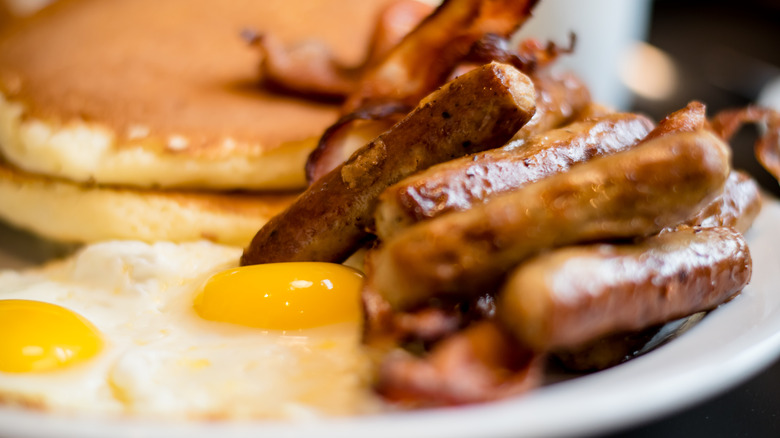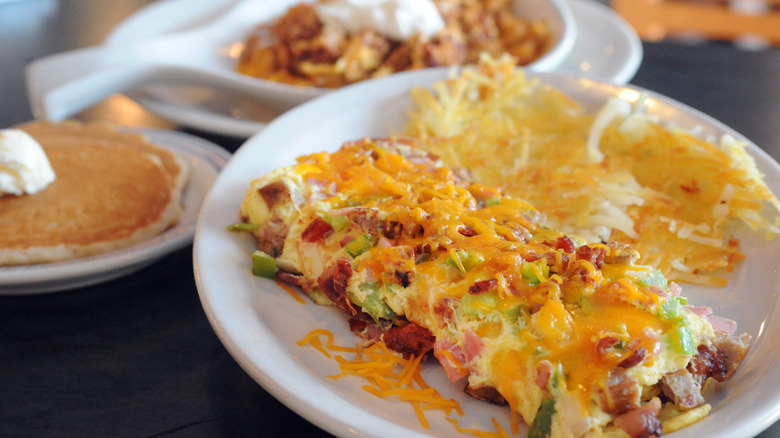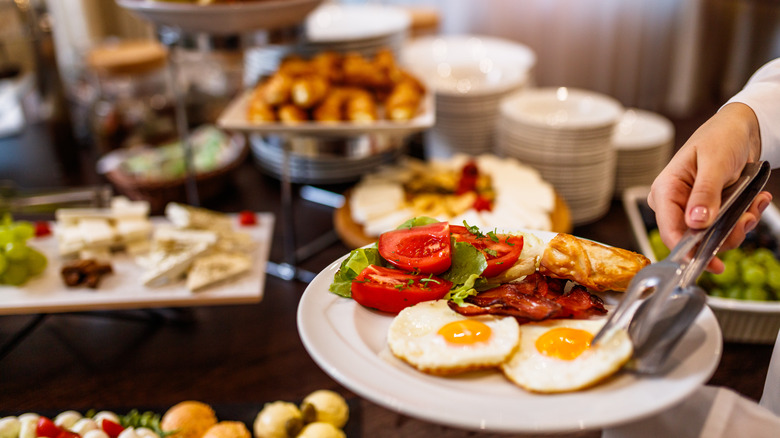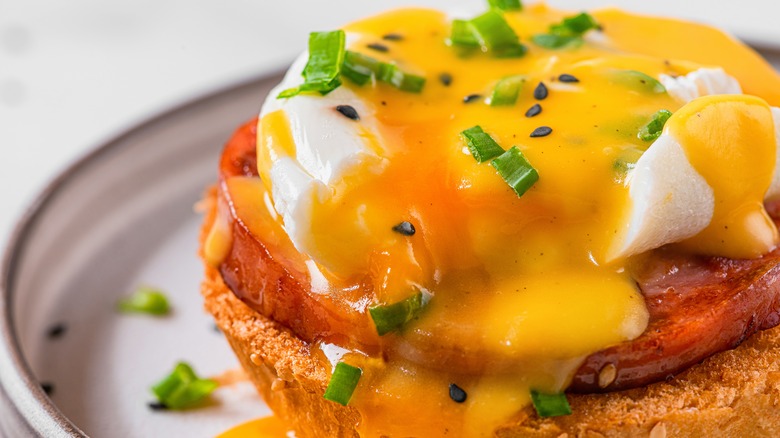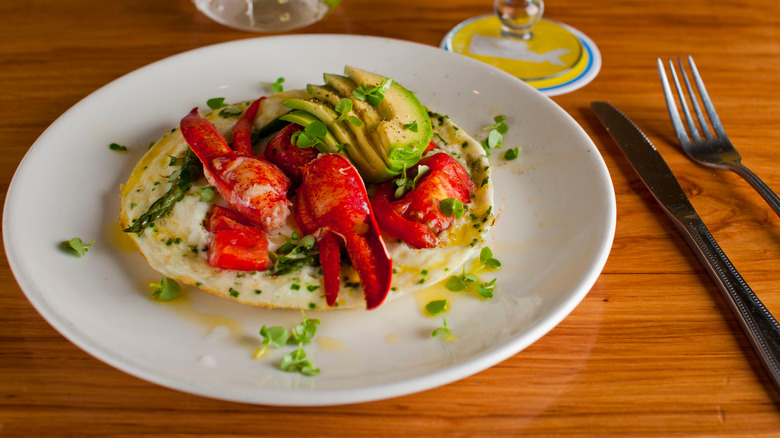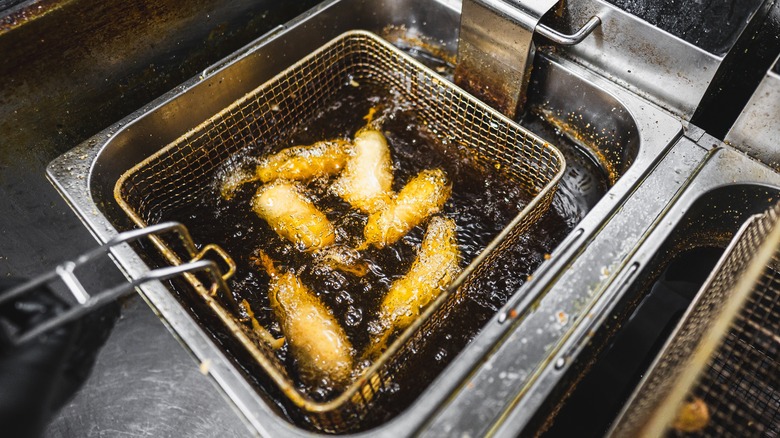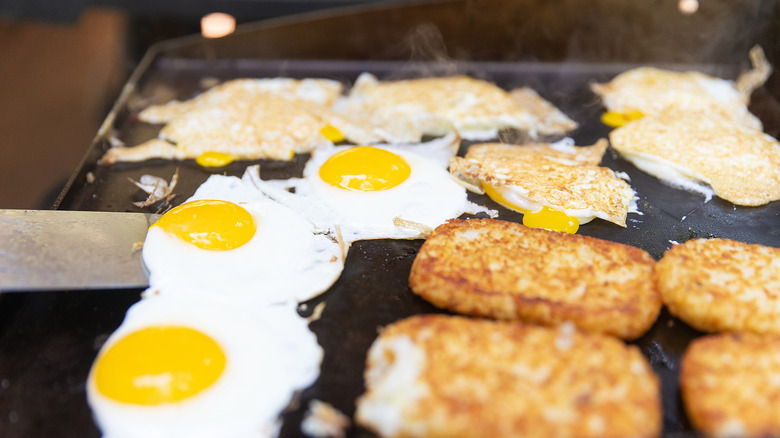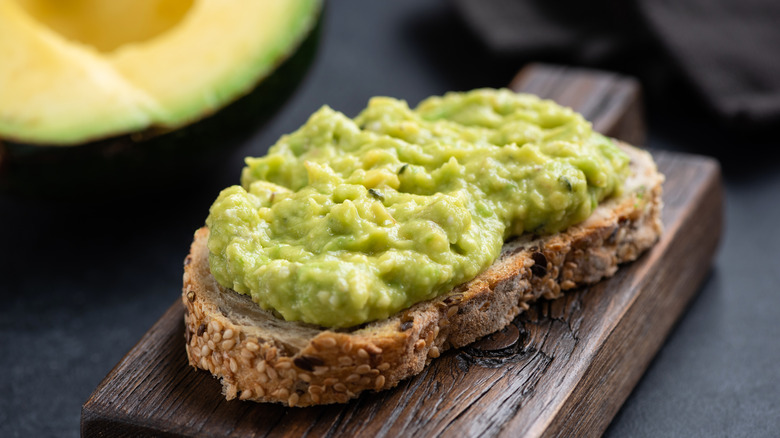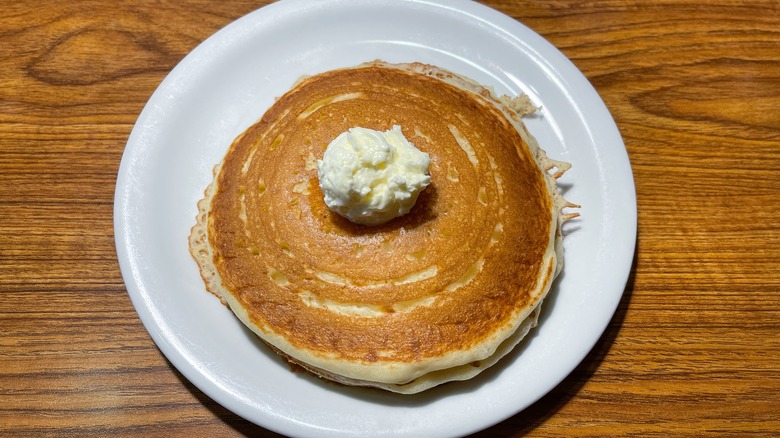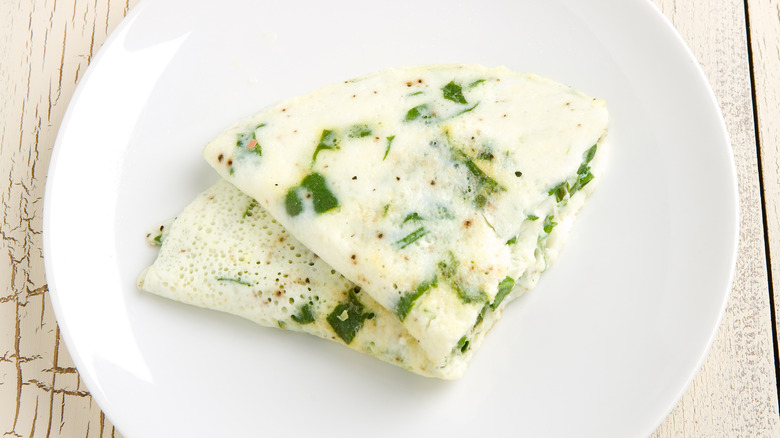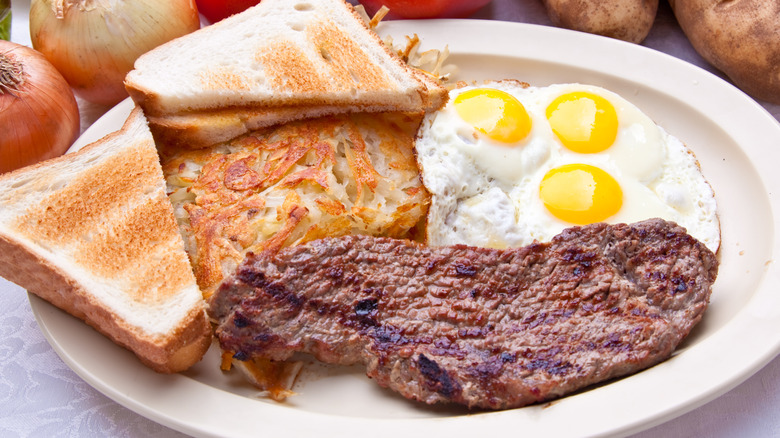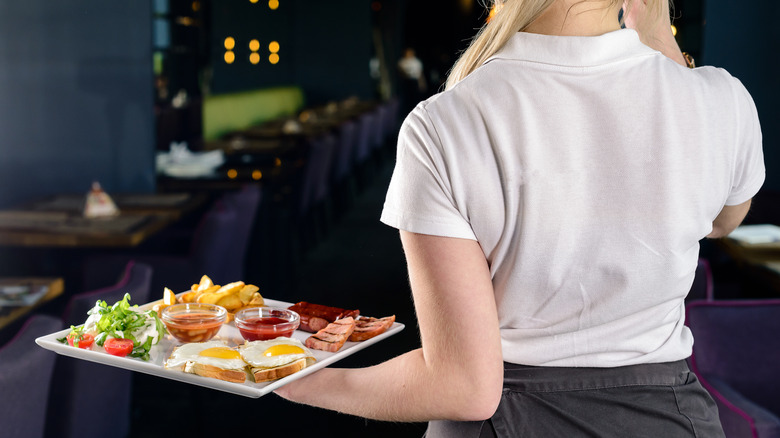This Insider Gives Us 11 Things You Should Think Twice About Ordering From Breakfast Joints
Going out to breakfast or getting brunch with friends on the weekends is one of life's small pleasures. It's also a way to refuel while traveling or any other time you're on the go. Regardless of why you visit a restaurant to enjoy the first meal of the day, there may be some things on the menu you want to avoid — and I'm ready to spill all the tea. Don't get me wrong, this isn't going to be a recreation of an episode of "Kitchen Nightmares." While most places aren't worthy of a full-blown Gordon Ramsay screaming explosion, many breakfast restaurants serve items that wouldn't live up to his extremely high standards either.
So, why should you believe me? Well, I worked in restaurants for 20 years, and several of the places I was employed served breakfast and brunch. I also spent many hours discussing experiences with other food service staff. I'll go more in-depth on my qualifications and methodology at the end of this article, but for now, suffice it to say I gathered numerous insights and have enough behind-the-scenes experience to know how things go down at restaurants. Keep reading to discover what all my years of experience taught me so you can avoid 11 questionable menu items, or at the very least, think twice before ordering them from breakfast joints.
Daily specials
Daily specials, like an omelet, pancake, or waffle of the day are pretty common in independent breakfast joints. They are an easy way for cooks to offer variety and keep things interesting. However, these dishes are also a great way to use up any food that may be past peak freshness, or close to it. Once an ingredient is hidden within a pancake or omelet, it is much trickier to determine freshness.
This technique for using up excess ingredients is fantastic for a kitchen's food costs, but might not be appealing to a discerning customer. For example, a spinach, tomato, and feta cheese omelet sounds delicious, but if you knew any leftover produce and cheese might be tossed at the end of the day, would it still be as "special" and enticing? My guess is no.
Another reason I would avoid ordering daily specials from a lot of breakfast restaurants is because they are generally priced higher than regular menu items. Regardless of whether or not the kitchen is simply trying to make the best of ingredients that are near spoiling or not, specials often come with a higher price tag because they appear shiny and new to guests. Pair the higher cost with the unpredictable nature of the ingredients used and that's more than enough to make me stay away.
Some buffet food, particularly if the restaurant doesn't offer it every day
Similar to daily specials, buffets are also a way for restaurants to off-load food that would otherwise be tossed in the next couple of days. This is particularly true if the establishment only offers a buffet once or twice a week. I worked at a spot like this. It only had a buffet on Sundays for brunch. While there were plenty of delicious food items available, it was primarily a way for the kitchen to run through a bunch of leftover food from the previous week. Basically, it wasn't the freshest or best display of what the restaurant was really capable of. Some of the things I would be especially discerning about are grilled vegetables, anything with a sugary fruit sauce, and bacon piled in a pan without any way to drain the grease.
But while a breakfast buffet is something to be wary of, you don't necessarily need to avoid them altogether. Many restaurants specialize in this type of offering — as you probably know, it's one of the things Las Vegas is known for. Even at the place I worked there were quite a few things on the buffet that didn't fall into a less-than-desirable category, like eggs, and made-to-order omelets and crepes. Just do your research (do people talk about how much they love it?), choose your breakfast buffet wisely, and you'll be more than fine.
Decaf coffee past noon if you value freshness
I'm one of those people who loves good coffee but is super sensitive to caffeine, so I totally understand the appeal of decaf brews. Even so, breakfast restaurants may not be the best place to enjoy them, especially if it is later in the day.
Coffee is one of the first things prepared in the morning before a restaurant opens. Not only does the staff need to fuel up before service, but a lot of guests at breakfast restaurants come in craving their morning caffeine fix. While this is great for several reasons, it also means that the decaf is made pretty early, and in my experience, not many people order it. In fact, decaf was typically only brewed once a day in many places I worked for this reason. What this means is that a huge pot of decaf sits in the kitchen or pouring pitchers for the entirety of service. If you come in later in the day, it's pretty much guaranteed that it won't be fresh.
The freshness of coffee isn't a deal-breaker for everyone, especially if it was still brewed the same day. However, many people take their coffee's freshness very seriously, even if it is decaf. If you are one of those people, I recommend staying away from decaf in breakfast restaurants if the spot has been open for more than a couple of hours.
Dishes smothered with hollandaise sauce
Found on dishes like eggs Benedict and croque madame, hollandaise sauce is a delicious breakfast sauce. It's rich, creamy, and flavorful, but it has to be done just right. It is actually a bit finicky. Professional kitchens are capable of making the sauce properly, but after that, its storage on the line (where food is plated and garnished before being served) might be questionable.
Hollandaise sauce is made with raw egg yolks, butter, and lemon juice, and it is not cooked. As a result, proper storage and use is key. According to the BC Centre for Disease Control, room-temperature egg yolks are a haven for bacterial growth, so they must be refrigerated. If not, they need to be eaten within two hours. In your kitchen, this likely isn't an issue, but it could be tricky for some breakfast spots.
Many breakfast joints make a large batch of hollandaise sauce before service. Then, it is kept on the line, often in a container over ice. However, the line is hot and there are typically heat lamps close by, so it's hard to keep food at a consistent temperature. This leaves a lot of room for error with hollandaise sauce. I've seen a tub of it sit on the counter for hours before being replenished with some from the fridge. With what we know about egg storage safety, this is more than off-putting. I'd say it's enough to warrant staying away from hollandaise in many restaurants.
Seafood if you aren't at a place that is known for it
If you are at a restaurant near the ocean known for serving fresh seafood, ordering a dish with shellfish or fish is most likely a solid choice. For everywhere else, you may want to reconsider your options. Crab and lobster omelets and frittatas may sound yummy, but quality is not guaranteed, especially if you are in a land-locked location. In fact, many restaurants simply use frozen seafood. This doesn't necessarily mean it isn't good, but it could definitely be better.
According to The U.S. Department of Agriculture, raw seafood shouldn't be left in the fridge for more than one or two days. After that, it needs to be cooked or frozen. While freezing extends the shelf-life indefinitely, the USDA also notes that the longer it stays in this state, the more the taste and texture diminish.
Many of the restaurants I worked in are in the landlocked state of Colorado, and all but one of them used frozen seafood to make their dishes. This makes sense for restaurants because it lowers food costs and ensures seafood doesn't spoil before being sold. For guests, it leads to reduced flavor and sometimes a rubbery texture.
Deep fried foods if you practice a gluten-free diet
If you practice a gluten-free diet, ordering deep-fried foods from a breakfast restaurant probably isn't the best idea. Even if you are ordering fried food that doesn't contain gluten, like french fries, chances are good that other glutenous foods were fried in the very same oil.
During my 20 years in the food service industry, I only worked in one restaurant that had a separate deep fryer reserved for foods that didn't contain gluten. Everywhere else, everything went into the same fryer. When guests let me know about their gluten-free diet, I immediately told them that the deep fryer was not compliant. Of course, some people threw caution to the wind and went for it anyway, but at least they were warned.
Gluten-free diets are much more than a fad. Sure, some people choose to cut gluten from their diets in an effort to stay trim (because it's in many high calorie foods) but lots of people have an intolerance or celiac disease which makes them allergic to it. For the most part, restaurant cooks take allergies and dietary preferences like this very seriously. After all, they want people to leave fed, not sick. If you let your server know about your gluten-free diet when ordering, they can easily inform the cooks so they take the proper precautions or steer you away from unsafe foods. If you don't, there's plenty of room for error behind the scenes, particularly when it comes to deep-fried foods.
Foods cooked on the flat top if you practice a plant-based diet
The flat top griddle in a restaurant kitchen is generally a crowded space, especially in high-volume breakfast restaurants. Often, everything from eggs to potatoes to french toast to bacon is cooked on the same surface. If you practice a plant-based diet, there's no guarantee your food won't touch meat or at the very least have grease transferred to it if it is cooked on the flat top. Even if you think eggs and potatoes should be fine because they are vegetarian, there's a good chance they will have encountered meat while cooking. For plant-based diets, this is a dealbreaker. Pancakes can also be cooked on the flat top but in my experience, they were kept pretty far away from meat so they are probably safe for vegetarians — always check with your server though.
Similar to gluten-free diets, restaurant chefs typically take care to prevent cross-contamination of meat and plant-based food items in the kitchen. However, since being a vegetarian or vegan is almost always a personal choice — and not an allergy — it's much more likely for some of the preventative details to fall through the cracks. In addition to this, you have to let your servers know about your dietary needs and feel good about them passing along the information to the kitchen. If you don't feel confident or prefer not to ask for special treatment, I strongly recommend you order food that isn't prepared on the flat top.
Basic avocado toast
Avocado toast seems to be all the rage these days, especially when the recipe includes more than the basic ingredients: avocado and toast. However, many restaurants choose to dial in their avocado toast recipe. Instead of making it something to be drooled over, they simply top toast with sliced, or slightly mashed avocado and nothing more. As a result, I find ordering this rendition of avocado toast from a restaurant pretty pointless. I can do that at home in a matter of minutes for a fraction of the cost. Plus, without a touch of seasoning, it's not that flavorful.
Many breakfast spots make yummy, restaurant-quality avocado toast with more than just the basics. When tasty seasonings, seeds, microgreens, fresh tomatoes, and any number of other toppings are added, avocado toast can be pretty delicious. So, if you're at a spot that does it right, there's no need to shy away from ordering it. If not, it may be best to simply leave it on the menu and opt for something else.
A la carte items like plain pancakes, yogurt, and bagels
At many breakfast joints, a la carte food items are a great way to round a meal. However, there are a few things, like plain pancakes, bagels, and yogurt, that don't necessarily provide much bang for your buck.
Let's start with plain yogurt. Whether flavored with something like vanilla or not, you pretty much know exactly what you're going to get when you order a side of yogurt. Even so, this doesn't mean it's a good or decent value option. Often, a restaurant will charge quite a bit for a small bowl of yogurt, and for the same price, you can pick up a big tub of it at the store.
Plain bagels are also something I avoid. In my experience, they were not ordered much, so they were rarely fresh. Instead, they were frozen and came out of the kitchen bland and tough. I have also found plain bagels to be pretty lackluster when I've ordered them from other places.
Lastly, plain pancakes aren't on my list of things to order from a breakfast place, and it seems I'm not alone in this. In a Business Insider article, a chef reveals that they stay away from them too because plain pancakes are too basic. Plus, restaurants have capable cooks in the kitchen who are more than willing to add yummy ingredients like blueberries, chocolate chips, or at the very least, whipped cream to their flapjacks.
Dishes with egg whites only
Eggs are the hero of breakfast, but according to a couple of chefs, they are only worth ordering if you get both whites and yolks in your dish. In a write-up in Business Insider, one chef notes that fatty egg yolks are delicious and when left out, it only leads to a drier breakfast overall. They are not alone in this sentiment. I remember more than one cook I worked with talking about how much they hate serving egg white omelets for the same reasons. Plus, guests were often more inclined to complain that dishes with only egg whites were dry, and there was not much the cooks could do to remedy the issue.
I know what you're thinking: Aren't egg white only dishes healthier, and therefore, worth a small sacrifice? Well, kind of. WebMD confirms that the yolks of eggs are where you find the majority of cholesterol and fat, so eating only egg whites is a viable way to reduce them in your diet. However, they also note that the yolk contains many of the vitamins as well (vitamins A, K, E, D, and DHA).
Egg white only omelets and breakfast dishes may be popular among some crowds, but they lack flavor, moisture, and as it turns out, nutrition too. So, depending on your priorities and expectations for a tasty restaurant breakfast, egg white only options may not be a great pick.
Well-done steak
Breakfast restaurants often use budget-friendly cuts of steak, like skirt and flat-iron for their steak and eggs and other dishes. Not only do they help keep food costs low, but they are thinner and cook faster. Plus, many people prefer a smaller steak first thing in the morning. It's not like dinner when many want a thick, hearty cut of beef. With all of this in mind, it makes sense for a breakfast restaurant to offer thinner, more cost-effective cuts of steak. However, ordering them cooked well-done is frowned upon by cooks.
Any steak cooked to a well-done temperature leads to a drier, tougher final product. With thin, breakfast steaks, it may even lead to a cardboard-like texture, which is something no one likes. I can remember several times when people ordered well-done breakfast steaks from me only to complain about them. After a while, I started warning people in advance — some listened, some didn't. You can avoid this mistake by ordering your breakfast steak medium-rare (what all the chefs I ever worked with said was the ideal temperature) and chances are good you'll get a tasty, juicy, tender steak from most quality breakfast joints.
Methodology
I worked in the food service industry for 20 years, and quite a few of the restaurants where I worked served breakfast and brunch. I had many roles during that time, including host, bartender, server, expo, food runner, and busser. Regardless of my position, I had a front-row seat to the amazing dynamic of restaurant kitchens. I also witnessed some less-than-desirable traits. It's been a couple years since I was employed in a restaurant, but some things you never forget — like what foods might be questionable.
You may not know this, but venting about a bad shift is a big part of food service employee culture. Discussing all the mishaps is a common way to decompress. As a result, I spent many post-shift hours listening to my colleagues and friends in the industry discuss issues they encountered, and some of that information helped inform me to write this article. I also reached out to a couple of people to refresh my memory and compile my list of 11 foods you may want to think twice about ordering from breakfast joints.
Of course, not all breakfast restaurants have the same issues. Many quality spots serve top-tier breakfast dishes, so don't let my recommendations scare you too much. It's places like Denny's and IHOP, along with small, lower-quality diners you should be wary.
If your interest is now piqued, check out this piece about the worst foods to order at a bar. You may be surprised at what you learn.

